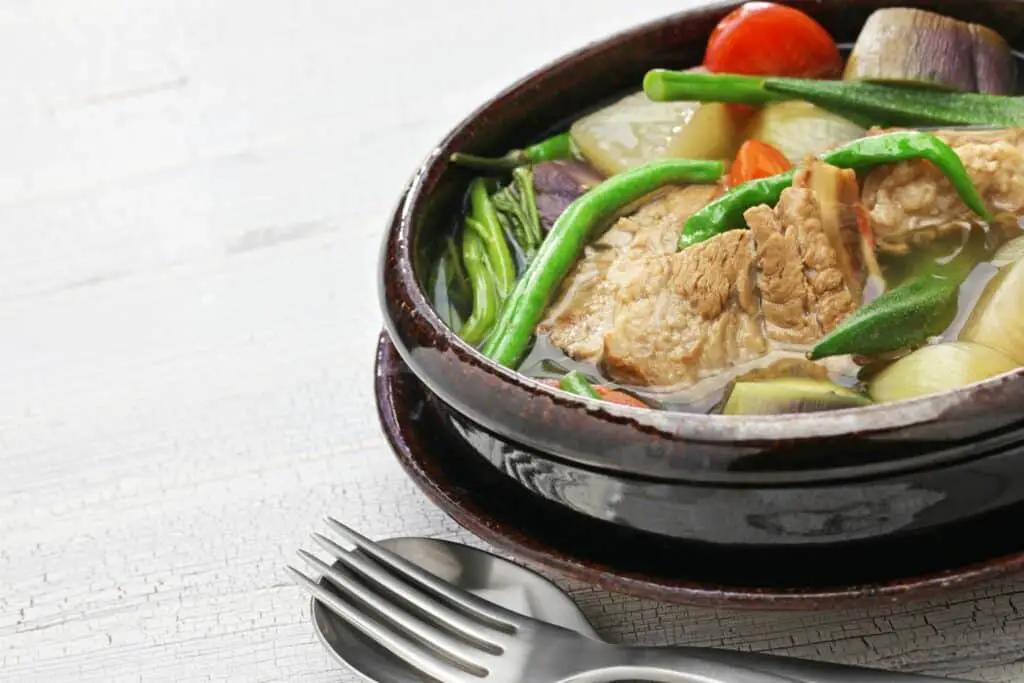
Most of the recipes on the internet for sinigang serves 4 or more, so if you live by yourself or even with a significant other, cooking sinigang might leave you with a lot of leftovers. Being able to freeze sinigang is an awesome way of preserving this delicious filipino food for a later time.
As a general rule, sinigang can be frozen up to 3 months. One caveat is that even though sinigang can be frozen for 3 months, the vegetables, especially leafy vegetables, will not taste fresh when warmed up, so it is advisable to remove leafy vegetables from the sinigang before freezing.
What are the different things you can do to keep your sinigang tasting fresh even after freezing? Read on to learn more.
Freezing Sinigang
When I was first starting to learn how to cook and figuring out how I can have hearty filipino meals with such a busy schedule, I asked my mom for advice. She said that batch cooking and freezing sinigang is the easiest way to make sure you can have sinigang quickly when the craving arises. I’ve kept this in mind over the years, and I think this is sound advice for those who have busy schedules, especially those who live abroad and perhaps live alone, as was my own situation at the time I got advice from my mom.
Batch cooking and freezing sinigang is the easiest way to make sure you can have sinigang quickly when the craving arises
Mrs. Mariano (aka. Mom), veteran filipina cook
Sinigang is a soup that is typically made with meat (pork, seafood, or beef), tamarind, and vegetables. It is a popular dish in the Philippines and is often considered to be a comfort food. When sinigang is frozen, it can last for up to 3 months. However, it is important to note that the quality of the sinigang will decrease over time. If you are looking to freeze sinigang, I would recommend doing so within 2-3 days of making the soup. This will help to preserve the flavor and quality of the sinigang.
If you’re looking to enjoy sinigang even in the colder months, then you’ll want to know how to freeze sinigang.
How Do You Store Sinigang?
As a general rule, sinigang should be stored in an airtight container. Ideally, the vegetables should be separated from the soup so that they do not absorb the soup and get soggy.
Below are a few simple tips for storing your sinigang in the fridge or freezer. Follow these steps so that you can enjoy your sinigang from frozen:
- Take out any leafy vegetables from the sinigang before freezing. These vegetables will not reheat well and will become mushy. Instead, add fresh leafy vegetables when you reheat the sinigang.
- Separate the liquids from the solids before freezing. This will help to prevent the sinigang from becoming watery when it’s reheated.
- Don’t fill your container up to the top when freezing sinigang. Leave some space for the soup to expand as it freezes.
- Be sure to label your container with the date when you froze the sinigang so that you can keep track of how long it’s been frozen.
Following these tips will help you enjoy sinigang all year round!
How long does sinigang last? Check out this post that talks all about this topic.
Preparing Frozen Sinigang For Eating
Now that you’ve frozen your sinigang, you are probably wondering how to unfreeze or thaw it in order to enjoy it for a meal. It’s easy to prepare sinigang from frozen. Read on to find out more!
The most important part of sinigang is the tamarind soup base, which gives the dish its unique sour flavor. Sinigang is typically served with rice and vegetables, and it can be made with either fresh or frozen ingredients.
If you’re using frozen sinigang, there are a few things to keep in mind.
First, make sure to thaw the sinigang completely before cooking. If you’re using frozen sinigang, after thawing, add enough water to cover the meat and vegetables.
Second, cook the sinigang on a low heat so that the flavors have a chance to meld together. Allow the soup to simmer for a few minutes. Sinigang is best enjoyed when all of the ingredients are cooked through and the soup has a rich, flavorful broth.
Finally, once your sinigang has been simmering for a few minutes, you can add your leafy vegetables such as kang kong, bok choy, or even spinach. Cover the pot and turn off the stove. Leave it for a few minutes to allow your leafy vegetables enough time to cook.
Why Would You Freeze Sinigang?
While sinigang is usually eaten fresh, there are a few reasons why you might want to freeze sinigang instead. Here are some reasons you might want to freeze sinigang:
Meal prepping is one reason to freeze sinigang – by pre-making sinigang and freezing it in individual portions, you can have an easy, healthy meal ready to go at any time.
Another reason to freeze sinigang is to save leftovers – sinigang reheats well, so freezing it can help to extend its shelf life.
Finally, if you love sinigang but don’t have the time to make it from scratch very often, freezing sinigang can help to satisfy your cravings.
Sinigang can be frozen in individual portions or in larger containers, depending on your needs. Whichever way you choose to freeze sinigang, it will be a delicious, convenient way to enjoy this Filipino classic.
How Long Is Sinigang Good For In The Fridge?
As a general rule, sinigang can last in the fridge for 2-3 days. So if you ended up with leftovers from cooking sinigang, you can leave it in the fridge and eat it within the next couple of days.
Other Ways Of Storing Sinigang
Another thing about sinigang is that it’s a popular dish to cook for large gatherings, but it can be time-consuming to make. If you don’t have time to cook sinigang constantly, the best way to preserve it is by freezing it. If you don’t want to freeze your sinigang, that’s totally fine! Sinigang can be stored in the fridge for 2-3 days, so if you plan on eating it in the next couple of days, this is a great option.
However, in room temperature, but sinigang will only last 4 hours. This is great to know if you plan on taking sinigang with you to work where there is no fridge. If you plan on taking sinigang with you, don’t worry, it travels well and can stay out of the fridge or freezer for 4 hours and will still be good to eat!

When To Eat And Not To Eat Sinigang
Now that you have a stash of frozen sinigang, it would be helpful to know when people typically eat sinigang and when they opt for a different dish. This section will discuss when you should and shouldn’t eat sinigang.
When Should You Eat Sinigang?
Sinigang is usually eaten for lunch or dinner and seldom at breakfast. Tt can also be a good choice when you’re feeling under the weather. In fact, many Filipinos find sinigang to be a comforting soup when they’re sick. Sinigang can also be a good option for parties or potlucks since it can be easily made in large batches. If you’re looking for a delicious and hearty soup, sinigang is a great choice. Just be sure to add extra rice to your bowl to soak up all the delicious broth.
When Should You Not Eat Sinigang?
Sinigang is a popular dish because it is so easy to make and can be enjoyed all year round. However, there are a few things to keep in mind when eating sinigang. First, sinigang tastes best when it is piping hot. If you are eating sinigang on a hot day, you may want to consider avoiding sinigang altogether or at least waiting until the temperature drops before enjoying your soup.
Also, since sinigang tastes best when piping hot, you may not want to eat this dish if you have no way of heating your food. For example, if you don’t have a microwave handy at work, perhaps you should bring something else to eat at work. Another example is if you are going on a picnic and don’t have a burner to bring with you, it is best not to bring sinigang.
If you want to know the best way to reheat sinigang, click here to read the article.

